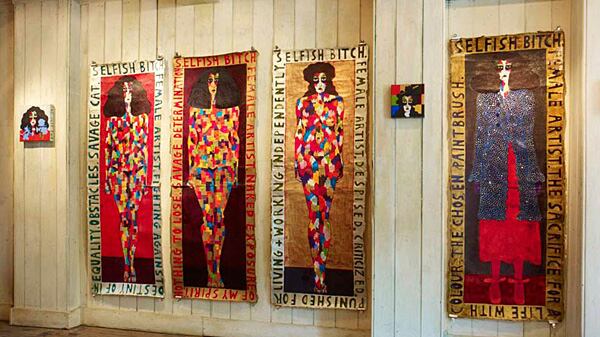Two years ago, when her show “Life So Far” opened at the Riflemaker gallery in London, Josephine King got her first real dose of art-world attention. The Guardian wrote her up and documentary filmmakers from Brazil filmed her for weeks in her studio in the South of France for a movie they wanted to make about her life. (The film is scheduled to be finished next year.)
All of that attention was unexpected—and King was so unprepared for it that it sent her into a full-fledged psychosis. She hallucinated for days. She saw spiders everywhere. But when she finally emerged from the worst of it, she went to work making hundreds of sculptures of spiders. Horror became catharsis. Now she’s back with a new solo show titled "Modern Woman," also at the Riflemaker, where the walls are covered with King’s signature self-portraits, all of them framed with running text. There is, for instance, Selfish Bitch #2, with the words, “Selfish Bitch. Female Artist. Ostracized. My Life evokes Hate, Jealousy, Envy, Anger. The price I pay” snaking around the long rectangle paper and the image of the artist naked, her skin covered in bright splotches, like some surrealist, full-body birthmark.
King has struggled with manic depression for most of her life, but wasn’t diagnosed or medicated for it until 1999. “If I don’t take my pills, all sorts of things go wrong,” she says in an interview at the gallery, wearing a hot-pink smock caked in a rainbow of paint splotches. Though she describes lithium as her savior, she admits to attempting suicide and succumbing to psychotic breakdowns. To cope, she draws about it, and is candid about her instability. For King, there’s still room for humor in all of this blackness. (See the 2007 painting Love Is Out, which declares in her tongue-in-cheek manner, “My psychiatrist was a chain smoker. I didn’t get a cure but I took up smoking.”)

When you talk to King, it’s inevitable to start considering the age-old question: Where, exactly, is the line between extraordinary imagination—the kind that makes an artist—and the dangerous delusions that can capsize them?
The relationship between madness, especially bipolar disorder, and creative achievement has been observed, documented, and explored for hundreds of years. One of the most famous examples, of course, is Vincent van Gogh, whose legacy hangs thick in the very city, Amsterdam, in which King spent most of her childhood. And the list goes on: Lord Byron, Paul Gaugin, Virginia Woolf, Georgia O’Keeffe. These are only a few of the many artists and writers thought to have had manic depression.
In her lauded book, Touched with Fire, the well-known bipolar psychologist and author Kay Jamison drills down into this issue. As Jamison emphasizes, it’s impossible to make the link between manic depression and artistic talent with any kind of clinical finality. To reduce it to some scientifically anointed cause and effect is impractical.
“My illness held me back a lot,” King says. “I was all over the place.” And yet, “the bipolar [disorder] has made me into an artist,” she says. “It gave me that madness and determination, the drive that never seems to go away. I have to paint.”
For King, obsession is a particularly salient point. She believes her illness has bestowed on her a single-mindedness that causes her to plumb the same waters again and again. She draws her body at various weights, heavy to emaciated. Naked and clothed. Her hair is alternately stiff as an Egyptian sarcophagus, pulled back in a French beret or the fluffy mess that resulted when, in the midst of a psychotic break a few years ago, she chopped it all off. All the work is done in vibrant inks, which result in a super-saturated color palette. The work has a slightly Fauvist feel, a primitive playfulness at odds with the gloomy expression on her face, steady from one painting to the next.
The famous psychiatrist Emil Kraepelin, writing in the 1920s, described the relationship between art and manic depression this way: “The volitional excitement which accompanies the disease may under certain circumstances set free powers which otherwise are constrained by all kinds of inhibition. Artistic activity namely may, by the untroubled surrender to momentary fancies or moods, and especially poetical activity by the facilitation of linguistic expression, experience a certain furtherance.”
Indeed, in their unabashed repetitiveness, King’s paintings speak to that “untroubled surrender” to emotion, to one’s inner state, whatever it may be. There’s an unguarded rawness in King’s work, a giving in, again and again, to whatever theme haunts her heart.
In her latest collection, King’s work explores a different theme sprung from another source of anguish that is inextricable from her manic depression. At 46, she’s single, childless, never married, and bruised from a series of bad relationships. Her current exhibition deals with all of these issues, and the larger theme of what it means to be a female artist. King’s message is blunt, as evidenced in one work: "I told him I was an artist; he said, Can you cook?"
King says that she especially hopes this show will reach women. “My female friends still seem to be stuck in the way my mother was stuck in the 60s. Through the decades, nothing really changes for women,” she says. “It isn’t easy to be an artist. You are very alone with what you do. You have to be very strong. No one asks you to do it. You just have to get up in the morning and do it—and women have to work even harder to prove themselves.”
And for all the young women who are working hard and on the cusp of establishing themselves, King has a bit of unequivocal advice, which she dispenses in her droll but absolutely sincere way: “They should think before they have a bunch of babies with an idiot.”






